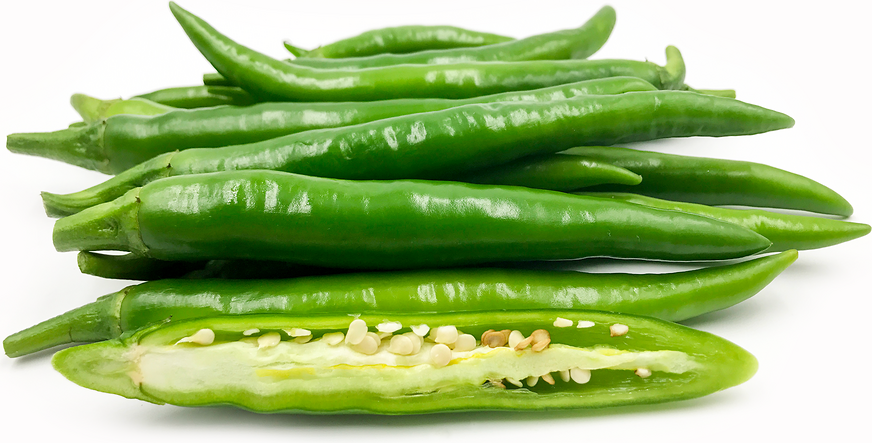


Green Chile Peppers
Estimated Inventory, lb : 0
Description/Taste
Green chile peppers widely vary in size and shape, appearing slightly curved to straight, and can contain different levels of spice depending on the individual variety. The pods can be long and slender, tapering to a point, or they can be wider with a conical shape, tapering to a rounded, blunt end. The skin is generally glossy and waxy, ranging from pale green to dark green, and the surface can be smooth or covered in wrinkles giving the pod a crinkled appearance. Underneath the surface, the flesh can vary in thickness and is crisp and pale green, encasing a central cavity filled with round and flat, cream-colored seeds. Green chile peppers are tangy, sharp, and pungent with a vegetal, earthy flavor and may be heatless or contain a moderate level of spice.
Seasons/Availability
Green chile peppers are available year-round.
Current Facts
Green chile peppers are botanically a part of the Capsicum genus and belong to the Solanaceae or nightshade family. There are many different varieties of peppers that are encompassed within the broad Green chile pepper category, and the majority of these peppers are immature pods that have not ripened to full maturity. Native to Central and South America, Green chile peppers have been spread across the world through trade and are a popular culinary ingredient used for their tangy flavor and milder spice. Green chile peppers are widely used in Asian, Caribbean, and Latin American cuisine in both fresh and cooked applications.
Nutritional Value
Green chile peppers are a good source of vitamins A, C, B, and E, potassium, and calcium. The peppers also contain capsaicin, which is a chemical compound that triggers the brain to feel the sensation of heat or spice. The capsaicin content in the green pepper is slightly lower than in its fully mature red state, but capsaicin has been shown to help stimulate the circulatory system and contains anti-inflammatory properties.
Applications
Green chile peppers are best suited for both raw and cooked applications such as stir-frying, sautéing, roasting, frying, grilling, and boiling. When fresh, Green chile peppers can be diced and added to salsas, salads, dips, relishes, and hot sauces. They can also be lightly stir-fried with vegetables, chopped and tossed into soups, stews, and curries, baked into bread, used as a topping for tacos, rice, and pizza, or pickled for extended use. Green chile peppers can be incorporated into savory dishes and are highly used in Southeast Asian, Indian, Cajun, and Latin cuisines. The peppers, depending on the variety, can also be used to infuse oils or alcohol and are often chopped and mixed into margaritas for a tangy bite. Green chile peppers pair well with meats such as poultry, beef, and pork, seafood, green tomatoes, sweet peppers, red onions, garlic, fruits such as mango, pineapple, and peaches, and herbs such as cilantro, mint, and oregano. The peppers will keep 1-2 weeks when loosely stored whole and unwashed in a paper or plastic bag in the refrigerator.
Ethnic/Cultural Info
Green chile peppers are widely used in Indian cuisine where the tangy, bright flavors and moderate heat are utilized as a flavoring in everyday cooking. Chile peppers are cultivated across India, and the extreme temperatures and high humidity contribute to many different pungent varieties that are available in large quantities for culinary use. Green chile peppers are often utilized in tadka, which is an Indian cooking technique that uses spices, peppers, and aromatics to create a flavorful base oil for cooking curries, rice dishes, dals, and lentils. This technique is what gives Indian food its famous, aromatic quality. Green chile peppers are also used in traditional dishes such as tikka masala or vindaloo, which are creamy curries, and pakodas, which is a popular street food of crispy fritters served with fried split Green chile peppers.
Geography/History
Green chile peppers are native to Central and South America and have been cultivated since ancient times. Spanish and Portuguese explorers then introduced the pepper in the 15th and 16th centuries to Europe and Asia where it has been widely developed for ornamental and culinary use. Today there are many different varieties of Green chile peppers that are grown around the world in Asia, Africa, Europe, Australia, the United States, Central America, and South America. The fresh peppers are commonly found through specialty grocers and farmers markets, and some varieties are cultivated by home gardeners.
Recipe Ideas
Recipes that include Green Chile Peppers. One
| Dessert for Two |
|
Green Chile Chicken Stew |
| Grow A Good Life |
|
Roasted Green Chile Sauce |
| I Am New Mexico |
|
Bacon Wrapped Stuffed Green Chile |
| Masala Chilli |
|
Kambu Dosai |

















